|
|
|
Sort Order |
|
|
|
Items / Page
|
|
|
|
|
|
|
| Srl | Item |
| 1 |
ID:
188068
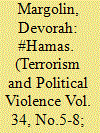

|
|
|
|
|
| Summary/Abstract |
As the debate on whether Hamas should be designated a terrorist organization intensifies across Europe and North America, policymakers and practitioners seek to identify the core principles that unify the group and its ideology. This paper contributes to this discussion by examining how Hamas uses Twitter to frame its narrative to English-speakers around the world. From March 2015 until November 2019, when its account was suspended from Twitter, Hamas operated an English-language Twitter handle under the name @HamasInfoEn. Using thematic content analysis to explore the first 2,848 tweets sent by Hamas in English—between March 2015 and March 2018—this paper explores the socio-political and religious narratives that lay at the core of Hamas’s online public diplomacy throughout its first three years on Twitter. Since its entrance into politics in 2006, some academics argue that Hamas has increasingly sought to distance itself from acts of terrorism and legitimize its actions as a governing actor, thereby seeking to carve out a place for itself in the international community. This study presents a nuanced understanding of how Hamas represents itself internationally, to better understand where the group is going, and how to best counter its narratives.
|
|
|
|
|
|
|
|
|
|
|
|
|
|
|
|
| 2 |
ID:
173803
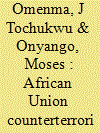

|
|
|
|
|
| Summary/Abstract |
Attacks from violent extremist organisations have reached unprecedented levels in Africa. Boko Haram, al-Shabaab, al-Qaeda in the Islamic Maghreb and Islamic State and Sinai Peninsula activities account for the majority of high attacks and fatality rates. Their membership cuts across national borders; some have established a presence in local communities, while others are controlling territories in a number of states. This continues to happen despite regional measures such as the Algiers Plan of Action on the Prevention and Combating of Terrorism (2002) and the African Model Anti-Terrorism Law (2011) to contain the activities of violent extremist groups on the continent. The prevailing argument shows that the African Union has initiated several legislations and protocols to contain terrorism on the continent, but the Union lacks the capacity to enforce legislations. Relying on the cost–benefit theoretical explication, we conclude that member states of the East African Community prefer to partner with external organisations in counterterrorism programmes which result in conflicting cross-border rules and challenges in countering violent extremism in Africa.
|
|
|
|
|
|
|
|
|
|
|
|
|
|
|
|
| 3 |
ID:
179904


|
|
|
|
|
| Summary/Abstract |
The subject of this research is the attitudes of Roma women on the topic of violent extremism and radicalization in Serbia. It is at times perceived that the Roma population, characterized by an extremely low socio-economic status, is a highly vulnerable group, and thus often victim to manipulation by religious extremists. Within this group, Roma women are doubly discriminated and disadvantaged—as minority group members, and as women, due to the patriarchal concept of the Roma community and its rigid hierarchical organization. With some exceptions Roma women are typically subordinated to their male family members. This research is based on in-depth interviews and focus group discussions during which the author spoke with male and female members of the Roma community. As the only such study to date, the preliminary conclusions suggest that Roma women can, particularly under the influence of their male family members, become followers of fundamentalist or even radical religious interpretations, but that as they have a very significant role in the upbringing of children, they also have the potential to act, early and preventively, in order to suppress extremist ideologies. Moreover, educated Roma women working in government institutions and the civil sector may have the most significant role in the prevention of violent extremism and radicalization, especially those involved in awareness-raising among the marginalized women of the Roma community.
|
|
|
|
|
|
|
|
|
|
|
|
|
|
|
|
| 4 |
ID:
188037
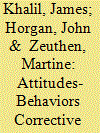

|
|
|
|
|
| Summary/Abstract |
Progress in understanding and responding to terrorism and violent extremism has continued to stall in part because we often fail to adequately conceptualize the problem. Perhaps most notably, much of our terminology (for instance, “radicalization”) and many variants of our existing models and analogies (including conveyor belts, staircases and pyramids) conflate sympathy for this violence with involvement in its creation. As its name suggests, the Attitudes-Behaviors Corrective (ABC) model seeks to overcome this issue by placing this key disconnect between attitudes and behaviors at its core. In this paper, we first present the key elements of our model, which include a graphic representation of this disconnect and a classification system of the drivers of violent extremism. The former enables us to track the trajectories of individuals in relation to both their attitudes and behaviors, while the latter helps ensure that we consider all potential explanations for these movements. We then adapt these elements to focus on exit from violence, applying the dual concepts of disengagement and deradicalization. Finally, we conclude with a section that aims to provide the research community and those tasked with preventing and countering violent extremism with practical benefits from the ABC model.
|
|
|
|
|
|
|
|
|
|
|
|
|
|
|
|
| 5 |
ID:
163210
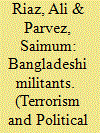

|
|
|
|
|
| Summary/Abstract |
Although militant groups have been present in Bangladesh since the 1990s, the country catapulted to international media attention on July 1, 2016, after an attack on a café in the upscale neighborhood of the capital Dhaka. The Islamic State claimed responsibility for the attack which killed 29 people, mostly foreigners. The attack came in the wake of a series of attacks on religious and ethnic minorities, foreigners, liberal activists, authors, and publishers by both an AQIS affiliate and ISIS. The government denied the existence of militant groups tied to international terrorist organizations. Despite these developments and instances of Bangladeshis joining the ISIS in Iraq and Syria, there has been very little in-depth discussion about who these militants are and what is driving Bangladeshis to militancy. This article addresses this lacuna. This paper examines the common traits of alleged Bangladeshi militants and explores the factors of radicalization. Drawing on media reports of the profiles of the alleged militants, between July 2014 and June 2015, and between July 2016 and August 2017, the article finds that most of the Bangladeshi militants are young, educated males increasingly coming from well-off families. We have also found evidence that four factors—social relationships, use of the Internet, personal crises, and external relations—appear most frequently in the narratives of Bangladeshi
|
|
|
|
|
|
|
|
|
|
|
|
|
|
|
|
| 6 |
ID:
144389


|
|
|
|
|
| Summary/Abstract |
[L]ocal people acting within civil society groups are responding to violent religious extremism in unprecedented ways.”
|
|
|
|
|
|
|
|
|
|
|
|
|
|
|
|
| 7 |
ID:
188058
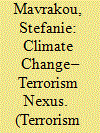

|
|
|
|
|
| Summary/Abstract |
A growing number of policymakers around the world have recognized climate change as an escalating security threat and increasingly point to the climate change—terrorism nexus in particular. This critical literature review provides an analysis of the current state of research on the causal and correlative links between climate change, intermediary factors—such as resource scarcity, loss of economic opportunities, and instability—and terrorism in sub-Saharan Africa. Moving beyond a review of substantive themes within the existing body of scholarly research examining this topic, this article critically evaluates the theories, assumptions, and methods behind the literature. In doing so, the review identifies noteworthy trends, as well as gaps and shortcomings in the current research. Our review finds that the majority of the literature has observed a positive correlation between climate change and terrorism. More precisely, the current body of research overwhelmingly assesses that climate change indirectly leads to terrorism via its impact on conditions often considered to be drivers of terrorism in sub-Saharan Africa. Still, gaps remain in empirically backing up these assertions and examining the relationship between climate change, intermediary factors, and terrorism in more depth. We use our critical review and analysis to guide recommendations for further research into this emerging and timely field of study.
|
|
|
|
|
|
|
|
|
|
|
|
|
|
|
|
| 8 |
ID:
188098
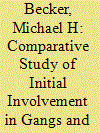

|
|
|
|
|
| Summary/Abstract |
There is a paucity of research comparing gang members and domestic extremists and extant studies find few explicit linkages. Despite this, there remains a great deal of interest in possible similarities between these criminal groups. Driving this interest is the possibility of adapting policies and practices aimed at preventing entry into criminal groups. A critical first step to determining compatibility is to examine the circumstances of the individuals who enter these organizations and better describe the entry processes. This study provides a unique comparison of entry into these groups by drawing on four broad empirically derived mechanisms of group entry using forty-five in-person interviews of U.S. gang members and thirty-eight life history narratives of individuals who radicalized in the United States. Our results reveal that each of the four conceptual categories appeared to influence initial involvement; however, no single mechanism described involvement in criminal groups or differentiated involvement across the gangs and extremist groups.
|
|
|
|
|
|
|
|
|
|
|
|
|
|
|
|
| 9 |
ID:
188089


|
|
|
|
|
| Summary/Abstract |
This study analyzes the effects of conspiracy beliefs on violent extremist intentions. More specifically, we investigate whether the relationship between conspiracy beliefs and violent extremism depends upon individual characteristics such as varying levels of self-efficacy, self-control, and law-relevant morality. Variable interactions examine where conspiracy beliefs exert strong effects on violent extremist intentions. The analysis is based on a German nationally representative survey (N = 1502). To our knowledge, it is the first and only nationally representative survey carried out in violent extremism research.
|
|
|
|
|
|
|
|
|
|
|
|
|
|
|
|
| 10 |
ID:
107153
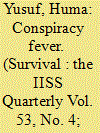

|
|
|
|
|
| Publication |
2011.
|
| Summary/Abstract |
The 2 May 2011 US special-forces raid on al-Qaeda leader Osama bin Laden's compound in Abbottabad marked a low point in already strained US-Pakistan relations. Although Washington provides more than $1 billion in annual aid to Islamabad, divergent strategic interests with regard to Afghanistan have caused friction between the allies, and many Pakistanis resent that they are on the front line of America's war against terrorism (over 4,300 civilians have been killed in terrorist attacks across Pakistan since 2007). This tension manifested on 14 May, when, in response to the Abbottabad raid, a joint session of both houses of the Pakistani parliament passed a unanimous resolution to defend the country's sovereignty, security and territorial integrity against US military actions.
|
|
|
|
|
|
|
|
|
|
|
|
|
|
|
|
| 11 |
ID:
152014
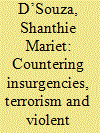

|
|
|
|
|
| Summary/Abstract |
South Asia continues to remains a hotbed of various forms of extremism. Indiscriminate violent terrorism with a strong religious overtone claims the highest number of victims, most notably in Pakistan and India. Islamist Jihadi movements backed by external actors keep the state of Jammu and Kashmir on a boil. Globally inspired Jihad in search of a shariah-ruled state has recurrently raised its head in Bangladesh. Linkages with global jihad and movements that have rallied support to an anti-West platform have escalated their violence potential. They remain a threat not just to the region but have demonstrated an inclination to network with groups having a trans-regional agenda.
|
|
|
|
|
|
|
|
|
|
|
|
|
|
|
|
| 12 |
ID:
117559
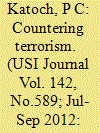

|
|
|
| 13 |
ID:
155341
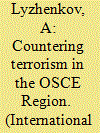

|
|
|
|
|
| Summary/Abstract |
THE HEINOUS ACTS OF TERROR in the first few months of the current year, indiscriminate slaughter of civilians, persecution of whole communities (particularly on the grounds of religion or belief), metro bombings, and terrorist attacks against major European cities continue to shock and horrify. Is it possible to take effective action against such atrocities? What can be done to prevent the assassination of an ambassador or a grenade launcher attack on a consulate general?* How can we enable people to travel by public transport, attend public events, and meet with friends in cafés and restaurants without fearing for their lives or for the lives of their children, friends and relatives?
|
|
|
|
|
|
|
|
|
|
|
|
|
|
|
|
| 14 |
ID:
183781
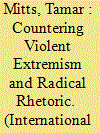

|
|
|
|
|
| Summary/Abstract |
How do extremist sympathizers respond to counter-radicalization efforts? Over the past decade, programs to counter violent extremism have mushroomed around the world, but little is known of their effectiveness. This study uses social media data to examine how counter-radicalization efforts shape engagement with extremist groups in the online world. Matching geolocated Twitter data on Islamic State sympathizers with granular information on counter-extremism activities in the United States, I find that, rather than deradicalizing, these efforts led Islamic State sympathizers to act strategically to avoid detection. After counter-extremism activities, the group's supporters on Twitter who were in the vicinity of these events began self-censoring expressions of support for the Islamic State, altered profile images and screen names, and encouraged followers to migrate to Telegram, an encrypted network not viewable by the public. These findings reveal previously unknown patterns in the effects of counter-extremism programs in the digital era.
|
|
|
|
|
|
|
|
|
|
|
|
|
|
|
|
| 15 |
ID:
185074


|
|
|
|
|
| Summary/Abstract |
Over the last six years, the P/CVE agenda has emphasized the need of preventative measures to augment kinetic counterterrorism security approaches. Based on field research in Kenya in 2019, this article analyzes the ‘police power’ of P/CVE, which compels populations to participate in their own security and ensure their own governability, otherwise marking them for elimination. P/CVE is read as a mode of civil counterinsurgency that operates to pacify populations seen as threats to a liberal international order through peacebuilding and development initiatives, curtailing the autonomy of civic space and securitizing the work of community organizations.
|
|
|
|
|
|
|
|
|
|
|
|
|
|
|
|
| 16 |
ID:
146380


|
|
|
| 17 |
ID:
079230
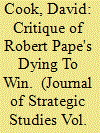

|
|
|
|
|
| Publication |
2007.
|
| Summary/Abstract |
Robert Pape's recent book Dying to Win is one of the most important statistical studies of the global phenomenon of suicide attacks to appear in the recent past. While Pape's basic thesis of the formula of occupation in addition to religious/cultural differences between the occupier and the occupied causing these suicide attacks holds up, there are a number of cases in which it does not. Additionally, some of Pape's historical and Islamic examples are weak. Before proceeding to an over-arching theory of suicide attacks it is important not to ignore the exceptions to Pape's theory.
|
|
|
|
|
|
|
|
|
|
|
|
|
|
|
|
| 18 |
ID:
188864
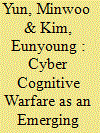

|
|
|
|
|
| Summary/Abstract |
Cognitive warfare has become the crucial war domain that determines the outcome
of modern wars. Joseph Nye pointed out, “in today’s war, it is not whose army
wins, but whose story wins,” emphasizing the importance of narratives to occupy
human minds and hearts. This has been repeatedly observed in the “War on Terror”
in Afghanistan and Iraq–Syria and the Russia–Ukraine war in 2014 and 2022.
The strategic importance of winning human cognition by the use of non-kinetic
influence operation had been similarly emphasized in the propositions of fifthgeneration warfare and Gerasimov’s suggestions. By recognizing the importance of
cognitive warfare, this paper attempts to address the concept of cognitive warfare
and suggest strategic and tactical principles for its practical operation and use.
The concept of cognitive warfare is still ambiguous, blurring together with related
concepts such as psychological warfare, information warfare, cyberwar, active
measures, and Reflexive Control. Besides, the substantial conceptual differences
between the U.S.–West and Russia have added more confusion. Thus, some
clarification to distinguish the concept of cognitive warfare from other related
terms seems necessary. Meanwhile, neither has there been any concrete proposition
of how cognitive warfare works strategically and tactically. The literature and
earlier reports only introduced various specific effects and techniques of cognitive
operations. Nevertheless, how these effects and techniques are strategically–
tactically integrated and jointly applied for a cohesive cognitive military operation
is yet to be proposed. This paper responds to two such issues of cognitive warfare.
In future warfare, the weight of cognitive warfare is anticipated to increase further.
Hopefully, this paper will be a stepping stone to rouse interest in cognitive warfare
and the development of its strategies and tactics.
|
|
|
|
|
|
|
|
|
|
|
|
|
|
|
|
| 19 |
ID:
156149


|
|
|
|
|
| Summary/Abstract |
Some scholars and others are skeptical of a significant role for the Internet in processes of violent radicalization. There is increasing concern on the part of other scholars, and increasingly also policymakers and publics, that easy availability of violent extremist content online may have violent radicalizing effects. This article identifies a number of core questions regarding the interaction of violent extremism and terrorism and the Internet, particularly social media, that have yet to be adequately addressed and supplies a series of six follow-up suggestions, flowing from these questions, for progressing research in this area. These suggestions relate to (1) widening the range of types of violent online extremism being studied beyond violent jihadis; (2) engaging in more comparative research, not just across ideologies, but also groups, countries, languages, and social media platforms; (3) deepening our analyses to include interviewing and virtual ethnographic approaches; (4) up-scaling or improving our capacity to undertake “big data” collection and analysis; (5) outreaching beyond terrorism studies to become acquainted with, for example, the Internet Studies literature and engaging in interdisciplinary research with, for example, computer scientists; and (6) paying more attention to gender as a factor in violent online extremism.
|
|
|
|
|
|
|
|
|
|
|
|
|
|
|
|
| 20 |
ID:
079229
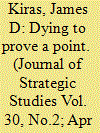

|
|
|
|
|
| Publication |
2007.
|
| Summary/Abstract |
Dying to Win is one of the most important works on suicide terrorism. It purports to unravel the strategic, social, and individual logic that gives suicide terrorism its coercive value. The methodology that Pape uses to support his various assertions is problematic for three reasons. First, he defines his key terms in such a way as to artificially set suicide terrorism apart from other forms of political violence. Second, in a number of cases Pape selects data from single sources to support particular assertions when other sources of data, used together, could provide more rigorous and useful insights into the phenomenon of suicide bombing. Finally, Pape codes his data on suicide attacks according to a loose set of criteria which, if recoded, calls into question some of his broader conclusions about the strategic utility of suicide terrorism campaigns.
|
|
|
|
|
|
|
|
|
|
|
|
|
|
|
|
|
|
|
|
|